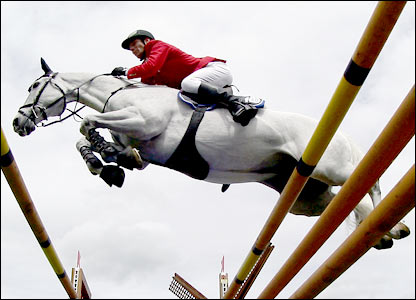tags: performance horses, polo, racing, tendon injury, stem cell research
Beat Maendli on board Principal clears a fence during the dressage and show jumping Grand Prix in Aachen, Germany.
Image: BBC.
Have you read the featured story in last week's issue of Science News? It is a fascinating look at the use of stem cells to treat injuries to leg tendons of performance horses. This treatment looks like it is successful, although no controlled studies have been done because, as you might suspect, horse owners are loathe to subject their prized horses to a controlled study where their horse has an even chance of receiving an injection of saline. However, a very small pilot study in eight horses that addresses this treatment method will be published soon in the peer-reviewed journal, American Journal of Veterinary Medicine.
Horses are especially prone to injuring their legs because their leg bones are very long and slender. When a horse is running at or near top speed, each foot strikes the ground separately, which means the animal's entire body weight of approximately 1,000 pounds, along with the momentum that is propelling the horse and its rider forward at 30-35 miles per hour, is borne on that one leg and its joints. In view of this data, it is surprising that more horses don't injure themselves.
Unfortunately, the statistics for a horse with a leg tendon injury are grim: only half of the horses that were treated for an injury to a leg tendon using conventional methods will return to their previous level of activity, and of these treated horses, between 40 and 50% of them will reinjure themselves.
After a tendon injury occurs, mature cells in the area heal the injury by producing scar tissue. Scar tissue is less flexible then the original tendon and therefore, more prone to reinjury. But unlike mature cells, stem cells retain their ability to transform themselves into any one of a number of different cell types, including tendon cells. So the basic premise for using stem cells to heal tendon injuries is the hope that the mature cells in the injured limb will induce these injected stem cells to become new tendon tissue instead of scar tissue.
But according to this recent Science News story, several veterinarians have pioneered the use of stem cells to treat tendon injuries in horses. So far, there are two sources for the stem cells that are used in this treatment; either the horse's own bone marrow, using a technique developed by Roger Smith of the Royal Veterinary College in London that is now available in this country through VetCell Bioscience, or fat cells taken from the horse's rump, a technique pioneered by Robert Harmon and his company, Vet-Stem. Both methods are fairly inexpensive -- costing only several thousand dollars -- especially when you compare the stem cell treatment method to the cost and risks associated with conventional treatments and the overall value of the average performance horse.
Stem cell treatment is reasonably simple: basically, stem cells are removed from the injured horse, grown in the laboratory for approximately three weeks, and then are injected into the injured tendon.
So far, both methods apparently show a good success rate. VetCell followed the fates of 82 horses for more than one year after stem cell treatment and found that 78% had returned to their previous level of physical activity. Unpublished data from Vet-Stem followed 66 horses that were treated using stem cells between 2004 and 2005 and found that more than 90% of these horses were injury-free one year later and 77% had returned to their previous levels of physical activity.
But because there have not been any peer-reviewed control sudies published yet, it is difficult to know how severe the horses' injuries were, and what was their level of performance when they finally returned to competition. Further, it is not known which source of stem cells -- bone marrow or fat -- is better able to generate healing, whether the stem cells were actually surviving after injection and what was the healing mechanism.
Interestingly, in 2007, VetCell Bioscience Ltd. changed its name to MedCell Bioscience Ltd. to reflect their future goal to develop stem cell treatments for people, too.
Source
Beil, L. Blind Bet (2008). Science News 173(3):40-41. 19 January 2008.


This sounds very interesting although several thousand dollars would be way more than most of the horse population is considered to be worth. I hope that more frequent use in the future might help to bring costs down.
I can understand the blind studies when working people because of the possibilities they might get better because of psychological issues related to being involved in the study. But with the horse, that's not going to happen. Why can't they compare x number of horses treated the traditional way and x number treated with the stem cells and use those statistics to decide how successful the treatment is.